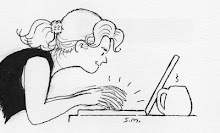"NO PITCHAS!"
I lowered my iPhone and walked over to the guard, who'd been yelling at me from 25 yards away and was now shaking his head with disgust.
"I'm sorry. I looked for a sign that said No Photography, but I didn't see one. Where is the sign?"
"You don't need a sign! There's no pitchas here!"
I paused. I spoke more slowly.
"But how do you know not to
start taking pictures if there's no sign?"
"I just told you—there's no pitchas!"
Yes, I'm back. Back in New York, land of the free, home of the nutty. God bless America.
My arrest-risking photo, taken in the rotunda of the courthouse where I went to postpone jury duty, caught my eye with its representation of Byzantine justice—a phrase that sounds ironic in more ways than one.
My Beloved and I have just returned from Turkey, whose nerve center, Istanbul, is the former Constantinople, capital of the Byzantine Empire. I think I was at a frat party when they offered Byzantine history in college, so I can't tell you what justice was like in that Empire, but it's not pretty in today's Turkey. Currently more than 100 journalists, 30+ mayors, and thousands of citizens have been thrown in prison by the current government; many of them remain there for years without trial.
The issue hung over us during an otherwise spectacular two weeks in this gorgeous country. It lingers, like the bruise on my knee that I got one late afternoon, walking up (up, up) an unpronounceable cobblestone street in Istanbul, where I waved at an old man on the third-floor balcony of a 19th century building and he waved back and I smiled and he smiled and I walked smack into one of the knee-high stanchions that separate the "driving" portion from the "walking" portion of the impossibly narrow street. The joy, the beauty, the bruise.
We were in Turkey thanks to the generous Aydın Doğan Foundation, who had invited Stan to be a juror for their 29th annual International Cartoon Competition. The competition was founded on the premise that "tolerance is more important than ever and that cartoons rely on
tolerance and wisdom, and form one of the building blocks of societies
open to differences of opinion and beliefs." I found this a particularly compelling and poignant mission statement, given that many of the competitors and half of the jurors came from countries where tolerance is on something of a sliding scale.
"Does the government tell your editor what he can and can't run?" Stan asked one of the Turkish cartoonists on the jury.
"They don't have to," came the translated reply. "He edits himself."
"In America," I said in the heavy lull that followed, "the only people editors are afraid of offending are advertisers."
Communication was sometimes a challenge during our week with the cartoonist-jurors. They came from Turkey, Iran, Ukraine, Portugal, China, England—and one single mild-mannered cartoonist from the U.S. Translators spoke Chinese and Turkish...or Portuguese and Turkish...or Persian and Turkish. Or a Turkish woman who spoke no Portuguese and a Portuguese cartoonist who spoke no Turkish would instead communicate in their shared language, French.
It was eye-opening and refreshingly humbling for two Americans to discover that the U.S. is
not the center of the universe.
But as My Beloved always says, English isn't his first language, anyway—drawing is. And if there was one thing these cartoonists did with no failure to communicate, it was
draw. They drew each other, they drew their translators, they drew the spouses. They drew me!
I might have hoped for a tiny bit more resemblance to Marilyn Monroe, but I am very fond of my caricature by the adorable Turkish cartoonist Tan Oral:
And of the interpretation by Ukrainian cartoonist and architect
Viktor Kudin:
"I look sort of sad, or serious," I said.
"A serious woman is very good!" he said in Russian.
Wanting to show my appreciation, I rummaged through my attic for appropriate responses. I put forth one as if I were offering a too-small sweater.
"
Das vedanya?" — "Goodbye?"
The day after the judging was over, the competition organizers treated us to a day sailing on the Aegean—the first and last time I'll ever feel like Jackie Onassis.
We sailed to a serene cove and parked the boat; then the swimmers among us jumped—I was very, very brave, and dove from the top step of the ladder, 8 feet above the water—into the unlikely turquoise-cerulean sea and swam with the tiny fishies who scuttled to the surface in search of bread. Then we sailed to another cove and started again.
At the end of the afternoon, we sailed back to the marina in the coastal town of Bodrum, where the cartoonists met some 12- and 13-year-old art students from the local school. Stan was matched with three boys, and assigned them to draw me while he drew each of them.
One boy had more English than the other two; he was a talker and joker, who drew everything in caricature.
Another was quiet and dead serious; his work was a flurry of erasures and redrawings, until he presented me with this:
The third boy, shy, sweet, and reticent, seemed to be searching for his own style among a host of others. Aren't we all?
"Enter mine in the cartoon competition," said the brash young caricaturist, confidently pressing his drawing into our hands.
We told him the winners had already been chosen for this year—but who knew what could happen next year? The future waits to be drawn.
To see the tied-for-first-place winners of this years International Cartoon Competition (and many others), click here.


























